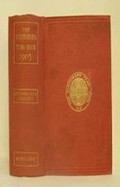Abstract
The Japanese claim that their empire was founded by the first Emperor Jimmu Tennō, 660 B.C., and that the dynasty founded by him still reigns. From 1186 until 1867 the emperors remained in a spiritual seclusion while Buccessive families of Shoguns exercised the temporal power on their behalf. In 1867 the Emperor Meiji recovered nominally the imperial power after the abdication on 14 October, 1867, of the fifteenth and last Tokugawa Shogun Keiki, known historically as Yoshinobu. In 1871 the feudal system (Hōken Seiji) was abolished; this was the beginning of the rapid westernization undertaken by the new government, then mainly controlled by the western clans of Satsuma and Chōshu. The Emperor bears title of Dai Nippon Teikoku Tennō (‘Imperial Son of Heaven of Great Japan’). Only foreigners make use of the poetical title ‘Mikado.’
Access this chapter
Tax calculation will be finalised at checkout
Purchases are for personal use only
Preview
Unable to display preview. Download preview PDF.
Books of Reference
Statistical Year-Book. Published by the Statistics Bureau of the Prime Minister’s Office. Tokyo. (From 1949.)
Statistical Abstract. Published by the Statistics Bureau of the Prime Minister’s Office. Tokyo. (From 1950.)
Monthly Bulletin of the Statistics Bureau. (From April, 1950.)
Commercial Conditions in Japan, April, 1950. H.M.S.O., 1951.
Japan Times Year Book. (I. Year Book of Japan. II. Who’s who in Japan. III. Business directory of Japan.) Tokyo, first issue 1933.
Akagi (R. H.), Japan’s Foreign Relations, 1542–1936. London, 1936.
Allen (G. C.), Japan: The Hungry truest. London, 1938.—Japanese Industry: Its Recent Development and Present Condition. New York, 1940.—Short Economie History of Modern Japan. London, 1946.
Benedict (Ruth), Chrysanthemum and the Sword. London, 1947.
Bisson (T. A.), Prospects for Democracy in Japan. New York, 1949.
Borton (H.), Japan since 1931. New York, 1940.
Bush (L. W.) and Kagami (Y.), Japanalia: Reference Book to Things Japanese. London, 1938.
Byas (H.), Government by Assassination. London, 1944.
Carus (C. D.) and McNichols (O. L.), Japan: Its Resources and Industries. New York 1944.
Chamberlain (B. H.), Things Japanene. London, 1935.
Cohen (J. B.), Japan’s Economy in War and Reconstruction. Minneapolis, 1949.
Colhert (E. S.), Left-wing Political Movements in Japan. New York, 1951.
Colrgrorr (K.), The Constitutional Development of Japan. Kvanston, Ill., 1951.
Embree (J. P.), The Japanese Nation: A Social Survey. New York, 1945.—Japanese Village Sue Mura. London, 1946.
Fahs (C. B.), Government in Japan. New York, 1940.
Farley (M. S.), Aspects of Japan’s Labor Problems. New York, 1951.
Fleisher (W.), Volcanic Isle. New York, 1941.
Gayn (Mark), Japan Diary. New York, 1948.
G err (Stanley), A Gazeteer of Japanese Place-Names. Cambridge, Mass. 1942.
Hall (R. K.), Education for a new Japan. New Haven, 1949.—(editor), Kokutai No Hongi. Cardinal Principles of the National Entity of Japan. Cambridge, Mass., 1949.
Hishida (Seiji), Japan among the Great Powers: A Survey of her International Relations. London, 1940.
Holtom (D. C.), Modern Japan and Shinto Nationalism. Chicago, 1947.
Ishii (Ryoichi), Population Pressure and Economic Life in Japan. London, 1937.
Johnstone (W. C.), The Future of Japan. New York, 1945.
Kiss (G.), Le Problème de la population au Japon. Paris, 1936.
Kobayashi (U.), The Basic Industries and Social History of Japan. 1914–1930. London, 1930.
Kuno (Yoshi S.), Japanese Expansion on the Asiatic Continent. 2 vols. London, 1940.
Latourette (K. S.), Short History of Japan. London, 1947.
Lory (Hillis), Japan’s Military Master. New York, 1943.
Macrae (H. A.), The Future Development of the Japanese Economy. H.M.S.O., 1948.
Mears (Helen), Year of the Wild Boar. London, 1943.—Mirror for Americans: Japan. Boston, 1948.
Mitchell (Kate L.), Japan’s Industrial Strength. New York, 1942.
Nachod (O.), Bibliography of the Japanese Empire, Being a Classified List of the Literature Issued in European Languages since the Publication of Fr. von Wenckstern’s Bibliography of the Japanese Empire [2 vols, 1895–1906] up to the Year 1929. 3 vols. London. 1931.
Norman (E. H.), Japan’s Emergence as a Modern State: Political and Economic Problems of the Meiji Period. New York, 1940.
Oshima (M.), Japan from Within. South Pasadena, Cat. (U.S.), 1940.
Pernikoff (A.), Bushido. London, 1943.
Praesent (H.) and Hamisch (W.), Bibliographie von Japan 1933–1935, mit Ergänzungen für die Jahre 1906–1932. Leipzig, 1937.
Price (Willard), Japan’s Islands of Mystery. New York, 1944.
Quiqley (H. S.), The New Japan: Government and Politics. Minneapolis, 1950.
Reischaur (E. O.) Japan: Past and Present. London, 1917.—The United States and Japan. Cambridge, Mass., 1950.
Sansom (G. B.), Japan: A Short Cultural History. London, 1931.—The Western World and Japan. New York, 1950.
Schumpeter (E. B.) (editor), The Industrialization of Japan and Manchukuo, 1930–40. New York, 1940.
Smith (G. H.) and others, Japan: A Geographical View. Washington, 1943.
Timperley (H. J.), Japan: A World Problem. New York, 1942.
Trewartha (G. T.), A Reconnaissance Geography of Japan. Madison, 1934.—Japan: A Physical, Cultural and Regional Geography. Madison, Wisconsin, and London, 1945.
Tsuchiya (Takao), An Economic History of Japan. London, 1938.
Uyehara (S.), The Industry and Trade of Japan. 3rd ed. London, 1939.
Wakefield (H.). New Paths for Japan. London, 1948.
Ward (R.E.), Guide to Japanese Reference and Research Material in the field of Political Science. Ann Arbor, 1949.
Yamada (Moritaro), Land Utilization in Japan, New York, 1951.
Yanaga (C.), Japan since Perry. New York, 1949.
Yanaihara (T.), Pacific Islands under Japanese Mandate. New York.1940.
Editor information
Copyright information
© 1951 Palgrave Macmillan, a division of Macmillan Publishers Limited
About this chapter
Cite this chapter
Steinberg, S.H. (1951). Japan. In: Steinberg, S.H. (eds) The Statesman’s Year-Book. The Statesman’s Yearbook. Palgrave Macmillan, London. https://doi.org/10.1057/9780230270800_42
Download citation
DOI: https://doi.org/10.1057/9780230270800_42
Publisher Name: Palgrave Macmillan, London
Print ISBN: 978-1-349-54903-0
Online ISBN: 978-0-230-27080-0
eBook Packages: Palgrave Political & Intern. Studies CollectionPolitical Science and International Studies (R0)

